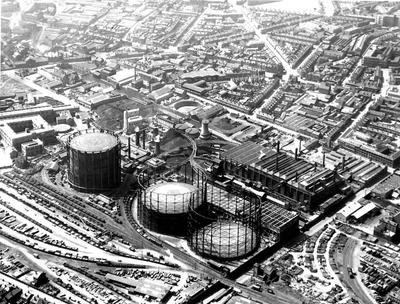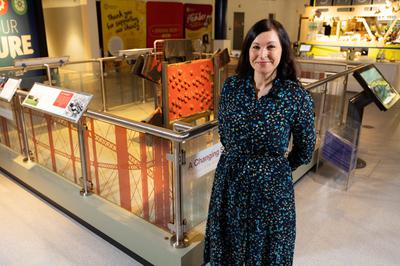News Story
- National Grid-sponsored display tells story of city’s last gasholders
- Claret and blue skyline structures familiar to thousands

A city landmark familiar to generations of families is being celebrated with a special exhibition at Birmingham’s Thinktank science museum.
The giant ‘twin’ gasholders in Windsor Street in Nechells were the largest in the world when they were first built in 1885.
Famously painted in the claret and blue of neighbouring Aston Villa FC they stood 46 metres high and 73 metres wide and were an important part of Birmingham’s industrial heritage. Thousands of motorists on the nearby A38(M) Aston Expressway passed the giant landmarks every day.
Until recently three gasholders remained in Windsor Street but the ones known as numbers 13 and 14 were nicknamed the ‘twins’ because they shared a frame.
The gasholders were part of the Windsor Street Gasworks which was built in 1846 by the Birmingham Gas Light and Coke Company.
The supply of manufactured gas, known as town gas, transformed life and industry in Birmingham by supplying light and power to homes and businesses.
The huge telescopic tanks rose up overnight as they filled with gas and sank back down during the day as the fuel was used by homes and industry.

Gas was manufactured in Windsor Street until 1974 when it was replaced by natural gas from the North Sea and other sources. But the storage facilities were used until 2012 when the fuel became stored by alternative means, including under pressure in the network of underground pipes.
As a result, National Grid dismantled Birmingham’s last remaining gasholders between February 2021 and November 2022 as part of a national programme to bring such sites back into use.
National Grid recognised the significance of the Windsor Street Gasholders to the local community, so it decided to donate one of the giant metal plates which once connected the ‘twin’ gasholders to Birmingham Museums’ collection as a way of making sure they are not forgotten.
It is now at the heart of a special display at Thinktank Birmingham Science Museum sponsored by National Grid.
Also on show are waders worn by one of the site workers who had to carry out the messy task of removing sludge from the base of the gasholders during their dismantling.

Laurence Butler, Thinktank Museum Manager, said:
“It is an honour for Thinktank to be able to display the gasholder connecting plate donated by National Grid. This unique object allows visitors to get close to an iconic part of the local skyline for so many years and to understand its story from construction to removal.
“The story of the Windsor Street gasholders connects engineering to social history and allows visitors to engage with a true piece of Birmingham’s heritage.”
Sarah Rea, Land Regeneration Manager at National Grid, said:
“Although the gasholders had not been used for many years, we recognised their long history and place in the local community and city skyline.
“We’re delighted to have been able to donate part of the gasholders to Thinktank and sponsor the exhibition so visitors can enjoy learning about them and secure their place in Birmingham’s industrial heritage.”

Did you know?
- Six thousand tonnes of metal were removed from the gasholder site for recycling by specialist Birmingham-based company DSM.
- Parts of the gasholder frames have also been donated to people who worked at the site, Aston Villa Football Club and Aston University Engineering Academy.
- Memories of people who worked at the site were also recorded as part of National Grid’s Capturing Stories initiative.